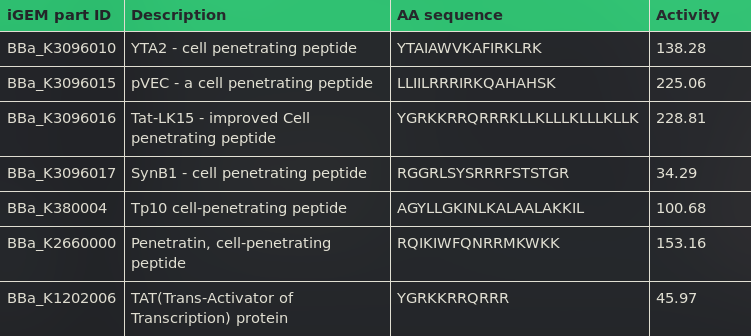Part:BBa_K3096016
Tat-LK15 - improved Cell penetrating peptide
TAT-LK15 is a short fusion peptide of the cell-penetrating peptide (CPP) TAT (transactivator of transcription) and the synthetic LK15 peptide. Adding LK15 to TAT results in improved transport efficiency across the cell membrane. The part has been reported to be able to transport nucleic acids through membranes, which allows novel transfection protocols (Saleh et al.). LK15 consists of 15 amino acids, which are all either leucine (L) or lysine (K) residue, resulting in an amphipathic protein (Saleh et al.).
Contents
Biology & Usage
Due to their penetrating activity, Cell penetrating peptides can be utilized as carriers of small therapeutic macromolecules or nucleic acids across membranes (Kamei et al.). Since cytotoxic effects have occurred, induced by the disintegration of the plasma membrane, improvement and development of cell-penetrating peptides are necessary.
Kamei et al. propose that cell-penetrating peptides gain their activity through the abundance of multiple positive charges (arginine, R) and the ability to form an amphipathic helix.
TAT is commonly used to deliver DNA across membranes in order to overcome the issues proposed by low transfection efficiency in cell culture (Saleh et al.). It consists of up to 35 amino acids of the HIV-1 full-length protein TAT (Wender et al.). Its penetrating activity is supposed to be induced by guanidinium groups (Wender et al.)
Saleh et al. showed that TAT's penetrative activity can be significantly increased upon the covalent attachment of LK-15 to TAT. Moreover, they demonstrated that TAT-LK15/DNA complex treatment results in stronger leakage of the membrane, which could be causing the increased transfection activity (Salah et al.).
Improvement of TAT (BBa_K1202006) by iGEM Tuebingen 2019
To improve TAT (BBa_K1202006), iGEM Team Tuebingen has hereby introduced TAT-LK15 to the iGEM registry. According to Saleh et al., DNA complexes with TAT–LK15 confer to a higher transfection efficiency than TAT. This can be confirmed by our software tool C3Pred (see below).
Characterisation of TAT-LK15

To use the tool and to get more information on how it operates, please visit the wiki of iGEM Team Tübingen 2019.
Biosafety
Together with professional safety officials, Team iGEM Tuebingen 2019 has evaluated the biosafety of cell-penetrating peptides and has come to the conclusion that cell-penetrating peptides are to be classified as BSL1.
Sequence and Features
Tat: RKKRRQRRRGGG-CONH2 LK15: KLLKLLLKLLLKLLK-COOH Tat-LK15: RKKRRQRRRGGGKLLKLLLKLLLKLLK-CONH2
- 10COMPATIBLE WITH RFC[10]
- 12COMPATIBLE WITH RFC[12]
- 21COMPATIBLE WITH RFC[21]
- 23COMPATIBLE WITH RFC[23]
- 25COMPATIBLE WITH RFC[25]
- 1000COMPATIBLE WITH RFC[1000]
References
- Saleh, Amer F., et al. "Improved Tat-mediated plasmid DNA transfer by fusion to LK15 peptide." Journal of Controlled Release 143.2 (2010): 233-242.
- Kamei, Noriyasu, et al. "Usefulness of cell-penetrating peptides to improve intestinal insulin absorption." Journal of Controlled Release 132.1 (2008): 21-25.
- Paul A. Wender, Dennis J. Mitchell, Kanaka Pattabiraman, Erin T. Pelkey, Lawrence Steinman, Jonathan B. Rothbard "The design, synthesis, and evaluation of molecules that enable or enhance cellular uptake: Peptoid molecular transporters". Proceedings of the National Academy of Sciences Nov 2000, 97 (24) 13003-13008; DOI: 10.1073/pnas.97.24.13003
| None |
